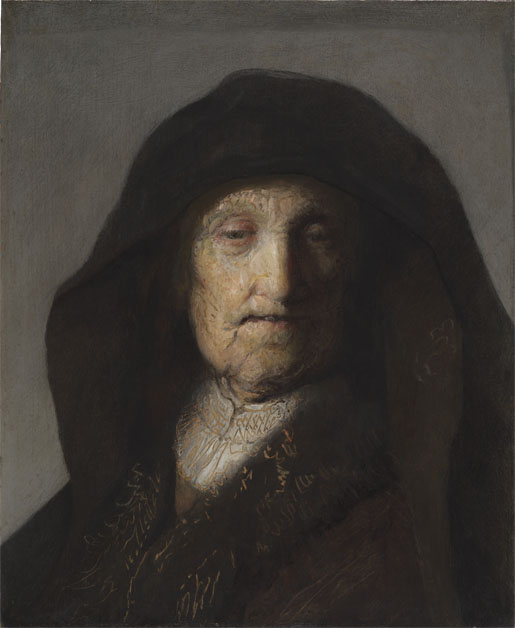The 1679 inventory of the estate of Clement de Jonghe (1624/25–77), an Amsterdam print dealer who had known and sat for Rembrandt van Rijn (1606–69), identifies, for the first time, the sitter in one of the master’s prints as “Rembrandts moeder” (Rembrandt’s mother).1 The exact etching referred to in this inventory is not known, but it was undoubtedly one of a number of images of an old woman that Rembrandt made in the late 1620s and early 1630s (fig 1). The identification of this sitter as Rembrandt’s mother is probably correct given the number of times that Rembrandt depicted her.2 She also served as a model for other Leiden artists, including Jan Lievens (1607–74)3 and apprentices in Rembrandt’s studio, among them Gerrit Dou (1613–75), Isaac de Jouderville (ca. 1612–48), and the unknown artists who painted Bust of an Old Woman (RR-122) and this expressive tronie.4
In this painting, Rembrandt’s mother wears a dark headdress that sweeps across her forehead and frames her face as it falls over her shoulders onto her dark, fur-trimmed robe. Beneath these austere coverings is a white blouse with an elaborately embroidered collar. The woman’s aged skin, which glows under the strong light coming from the left, is rendered in a network of small strokes and splotchy dabs of paint, including ochre highlights and vivid red accents on her proper right eye and bottom lip. Angular marks boldly scratched into the wet paint, sometimes with the blunt end of a brush and sometimes with a reed pen, not only indicate folds and wrinkles in her face, but also the decorative patterns in her white blouse and fur trim.5 The expressive brushwork and scratches in the paint, as well as the strong contrasts of light and dark that divide her face along the bridge of her nose, indicate that this panel was not conceived as a portrait but as a tronie, or character study, where the artist has captured both the inner dignity and the effects of time on the face of this aged woman.
The artist who painted this tronie looked carefully at Rembrandt’s 1628 etching of his mother’s visage (fig 1), where she similarly gazes directly out at the viewer and wears the same black headdress. Rembrandt indicated the many wrinkles covering her face with delicate etched lines, and expressively modeled the image to capture effects of light and dark. The artist who made the Leiden Collection painting sought to emulate these characteristics, but exaggerated them, not only with his broad application of paint but also in the angular rhythms of the calligraphic hooked strokes of his scratched lines.6
Ernst van de Wetering has sought to group this tronie with two other paintings by an unidentified artist from Rembrandt’s workshop: A Man Seated Reading at a Table in a Lofty Room, ca. 1628–29 (National Gallery, London) (fig 2) and Travellers Resting (The Rest on the Flight into Egypt?), ca. 1629–30 (Mauritshuis, The Hague) (fig 3).7 He noted that these three paintings have technical and stylistic similarities, in particular the way in which the artist scratched into the wet paint to form outlines, an approach that differs from the way Rembrandt used his scratching technique to create textural effects.8 Aside from the use of Rembrandt’s mother as a model and the superficial similarities in painting techniques, dendrochronological analysis also connects this painting to Rembrandt’s studio: the panel support was cut from the same tree as that for Rembrandt’s Self-Portrait, ca. 1628 (Indianapolis Museum of Art).9
X-radiographs indicate that this tronie was painted over another image—a soldier with a broad hat and staff (fig 4). The soldier’s form is also visible at the right of the panel in raking light. Indeed, some of the “dead-coloring” revealed because of the scratching may be paint from this original image.
This expressive tronie is a fascinating example of a work produced in Rembrandt’s workshop during his Leiden years, yet it also serves as reminder of how much is still to be learned about the character of that studio. We still do not have a firm sense of who was in the workshop in the late 1620s other than Gerrit Dou, and we do not really know how Rembrandt taught pupils about his complex painting techniques. Was a work such as this painted from life or modeled after one of the master’s prints? Did he challenge his students to paint an image with strong effects of light and dark and to capture an image of age as part of his pedagogical process? Did he authorize works such as this for sale, and, if so, were they sold under his name? Works such as this tronie are compelling to look at and to reflect upon for their emotional qualities, but they also help us develop a richer understanding of the master who inspired them.
